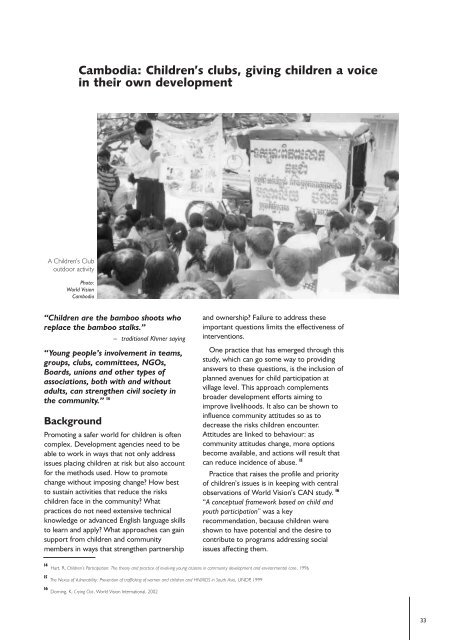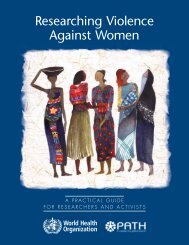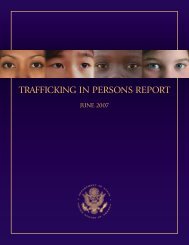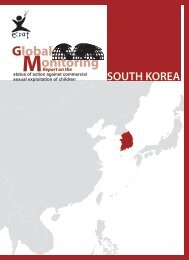Download PDF - Violence Against Children - East Asia and the ...
Download PDF - Violence Against Children - East Asia and the ...
Download PDF - Violence Against Children - East Asia and the ...
You also want an ePaper? Increase the reach of your titles
YUMPU automatically turns print PDFs into web optimized ePapers that Google loves.
Cambodia: <strong>Children</strong>’s clubs, giving children a voice<br />
in <strong>the</strong>ir own development<br />
A <strong>Children</strong>’s Club<br />
outdoor activity<br />
Photo:<br />
World Vision<br />
Cambodia<br />
“<strong>Children</strong> are <strong>the</strong> bamboo shoots who<br />
replace <strong>the</strong> bamboo stalks.”<br />
– traditional Khmer saying<br />
“Young people’s involvement in teams,<br />
groups, clubs, committees, NGOs,<br />
Boards, unions <strong>and</strong> o<strong>the</strong>r types of<br />
associations, both with <strong>and</strong> without<br />
adults, can streng<strong>the</strong>n civil society in<br />
<strong>the</strong> community.” 14<br />
Background<br />
Promoting a safer world for children is often<br />
complex. Development agencies need to be<br />
able to work in ways that not only address<br />
issues placing children at risk but also account<br />
for <strong>the</strong> methods used. How to promote<br />
change without imposing change? How best<br />
to sustain activities that reduce <strong>the</strong> risks<br />
children face in <strong>the</strong> community? What<br />
practices do not need extensive technical<br />
knowledge or advanced English language skills<br />
to learn <strong>and</strong> apply? What approaches can gain<br />
support from children <strong>and</strong> community<br />
members in ways that streng<strong>the</strong>n partnership<br />
<strong>and</strong> ownership? Failure to address <strong>the</strong>se<br />
important questions limits <strong>the</strong> effectiveness of<br />
interventions.<br />
One practice that has emerged through this<br />
study, which can go some way to providing<br />
answers to <strong>the</strong>se questions, is <strong>the</strong> inclusion of<br />
planned avenues for child participation at<br />
village level. This approach complements<br />
broader development efforts aiming to<br />
improve livelihoods. It also can be shown to<br />
influence community attitudes so as to<br />
decrease <strong>the</strong> risks children encounter.<br />
Attitudes are linked to behaviour: as<br />
community attitudes change, more options<br />
become available, <strong>and</strong> actions will result that<br />
can reduce incidence of abuse. 15<br />
Practice that raises <strong>the</strong> profile <strong>and</strong> priority<br />
of children’s issues is in keeping with central<br />
observations of World Vision’s CAN study. 16<br />
“A conceptual framework based on child <strong>and</strong><br />
youth participation” was a key<br />
recommendation, because children were<br />
shown to have potential <strong>and</strong> <strong>the</strong> desire to<br />
contribute to programs addressing social<br />
issues affecting <strong>the</strong>m.<br />
14 Hart, R, <strong>Children</strong>’s Participation: The <strong>the</strong>ory <strong>and</strong> practice of involving young citizens in community development <strong>and</strong> environmental care, 1996<br />
15 The Nexus of Vulnerability: Prevention of trafficking of women <strong>and</strong> children <strong>and</strong> HIV/AIDS in South <strong>Asia</strong>, UNDP, 1999<br />
16 Dorning, K, Crying Out, World Vision International, 2002<br />
33

















